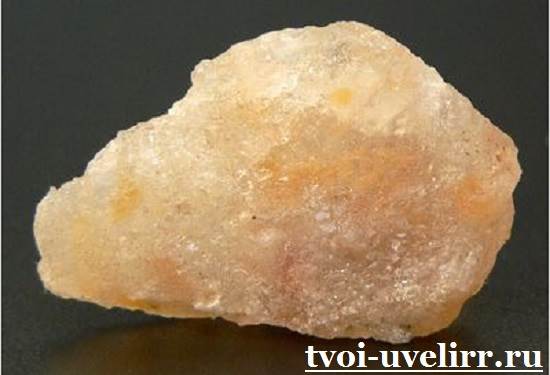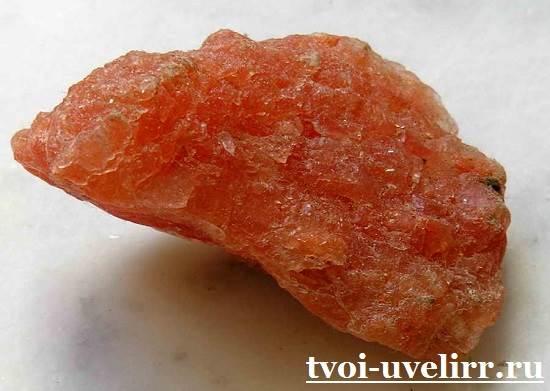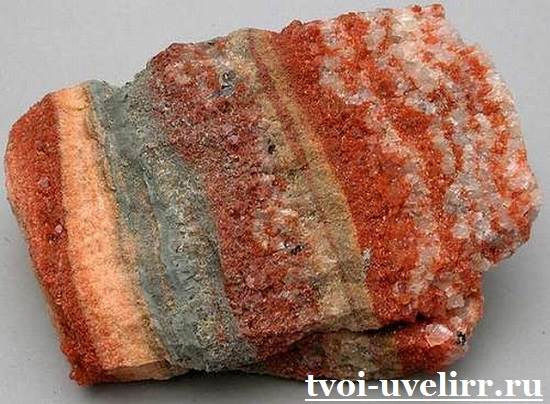Description of the sylvin. Sylvin properties. The use of sylvin
Silvin belongs to the group of halites, consisting of metal chlorides K and Na. The mineral sylvin was first found in Italy in 1832 and was named after the 17th century scientist Francis de La Boe. Francis was the first to investigate the digestive properties of this material.
Description and properties of sylvin
Sylvin is potassium chloride, having similar external and functional characteristics with halite. They are similar, first of all, in that they have a similar crystal lattice and both form regular cubic crystals during crystallization, very similar to dice.
Due to the presence of octahedral faces, the edges have a smoothed shape. Sylvin is a mineral, consisting of K (52.2%), Cl (47.5%), nitrogen, liquid inclusions, hydrogen, carbon dioxide, methane and helium.
Sylvin also often contains mechanical impurities: iron oxide and sodium chloride. The mineral contains KBr, CsCl, and RbCl as isomorphic impurities.
Silvin, formula which consists of a monovalent metal, belongs to the cubic system and has a hexaoctahedral shape. It has a face-centered crystal structure, which also refers this mineral to the halite group.
However, unlike the galita sylvin has a much larger unit cell. Externally, the crystals have the shape of a cube. It is also not uncommon to find aggregates with a mass of granular structure, which have a dense layered texture.

The color of sylvin is quite uniform: from colorless to water-transparent. Sometimes a milky shade prevails, which is achieved due to small inclusions of gas bubbles. The exception is pink and red sylvin, which are formed as a result of the presence of small flakes of iron oxide.
When dissolved, iron remains in the precipitate. Sylvin has a vitreous luster, which makes it especially attractive for industrial applications.
Sylvin hardness has an average value of 1.5-2. When pressed and scratched, the plasticity of the material is detected. The specific gravity is 1.97-1.99. Sylvin break uneven, stepped.

It has perfect cleavage, high thermal conductivity. It has a salty-bitter taste. It is quite easy to dissolve the material in water, which is its hallmark. Rays of short and infrared waves penetrate through sylvin, which makes it suitable for use in a spectroscope prism.
Sylvin melts at 800 degrees Celsius. After reaction with nitric acid, it forms a white cheesy precipitate.
Deposits and mining of sylvin
Silvin, origin which is the same as halite, is formed as a result of the drying of high-density salt lakes. However, it is not every time that you can meet exactly sylvin in a rock salt deposit. What can not be said about Galita.
In the process of formation, the stone is partially adsorbed by the soil. Since sylvite has a lower density, it precipitates last, resulting in the extraction of the mineral in the upper layers of salt accumulations. Also origin of sylvin may turn out to be secondary: to be a product of carnallite separation.

Sylvin is formed from the evaporation of sea water. As a sublimation product, sylvin is found in solidified lava and on the surface of craters of an active volcano.
Perm is home to the largest sylvin deposit is the Solikamsk vault, which was found in 1925. There are deposits of halite-sylvin rock located at a depth of about 200 m underground. At this depth, rock salt is covered with a vast zone of carnallite.

Also, the extraction of sylvin was widely organized in the Stassfurt deposit, as well as in Western Germany. Here, salt deposits are quite widespread. There are sulfate, and halogen, and boric compounds. The mineral is mined underground.
Relatively young sylvin deposits are located in France in Alsace, in India, Spain, Canada, where oil drilling was carried out in 1943.
The use of sylvin
The use of sylvin very extensive. First of all, it is agriculture. Potassium salt is used as fertilizer for fields.
Potash fertilizers are very beneficial for stable plant growth. Potassium is one of the most essential and useful substances. It is potassium that is not an integral part of the plant, which makes its use indispensable.
Potash fertilizers based on sylvin make seedlings more hardy and resistant to frost, the fruits are formed faster and more fully.
If suddenly the leaves began to turn yellow or become stained, became lethargic and lifeless, this is a clear sign of a lack of potassium. Significant use of potash fertilizers is necessary in the process of growing beets, buckwheat, potatoes, sunflowers and other vegetables.

Silvin is used in the chemical industry as a raw material for many compounds, which are further used in perfumery, medicine, photography, glass, industry, and in the production of paints and varnishes.
The most beautiful and attractive sylvin, photo which can be seen on the Internet, has bright orange and blue hues and is mined in Russia.
Also, transparent forms of the mineral are used in optical instruments. Sylvin is used to produce potassium metal structure. In the future, it is planned to build a power plant that will operate on the basis of liquefied potassium and convert thermal energy into electrical energy.
Recently, sylvin has found its application in homeopathy. It has an active intracellular ion that helps regulate various body functions.
The human heart quickly responds to increased or decreased serum potassium by decreasing or increasing excitability, respectively. Significant doses of potassium reduce myocardial contraction. If potassium rises by 4 times, this can lead to cardiac arrest.

However, this can only be done through intravenous infusion. A decrease in potassium in the blood increases the likelihood of developing arrhythmias, and the risk of glycosides affecting the heart muscle decreases. Potassium helps regulate the rhythm of the heart.
Potassium helps to improve the contractile functions of the muscles, avoiding dystrophy and myasthenia gravis. Back in the 19th century, Schüssler proposed the use of sylvin in the inflammatory process for the transition of a substance from a serous to a fibrous state. This mineral easily liquefies the internal secret.
Sylvin price
The price of potassium chloride varies from 30 to 300 rubles per kilogram. Often sold as a raw material for the agricultural industry.
Sold in powder, as a potassium salt. It is odorless, caking during storage and hygroscopic. Sylvin price mostly depends on its purpose. For medicine, more pure and homogeneous potassium chloride is used, the cost of which is somewhat higher.
